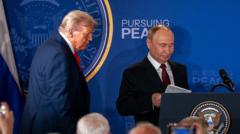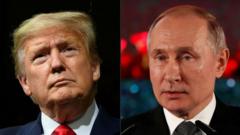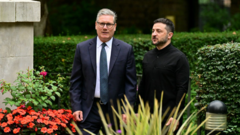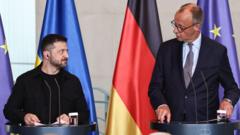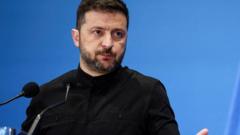Rutte's proposal seeks to escalate member nations' defense budgets to 5% of GDP, aiming to strengthen collective security while easing US concerns about underfunding.
**Nato Aims for 5% Defense Spending Target to Satisfy Trump**

**Nato Aims for 5% Defense Spending Target to Satisfy Trump**
Nato Secretary General Mark Rutte pushes for increased defense spending in a bid to meet Donald Trump's demands ahead of the upcoming summit.
In a strategic move to appease former President Donald Trump, Nato Secretary General Mark Rutte is advocating for a bold increase in defense spending to 5% of member nations' gross domestic product (GDP) ahead of the alliance's forthcoming summit. This initiative aims to prevent a repeat of the uncomfortable 2016 summit, where Trump criticized European allies for not contributing adequately to their own defense, to the detriment of American taxpayers.
Presenting the proposal at a press conference in Brussels, Rutte recognized the financial challenges this demand poses for many European countries. Current guidelines dictate a defense spending target of 2% of GDP, which many nations have struggled to meet. Rutte’s proposal would not only double this target but also prompts speculation on whether it is as much about deterring Russia as it is about satisfying the expectations of the US administration.
The proposed framework aims to ease some of the financial pressure, charting a path to a 3.5% commitment from members for core defense expenditures, with the remaining 1.5% identified for "defense-related expenditure." This loose categorization allows countries more flexibility in how they allocate their funds, potentially including aspects like infrastructure development.
Rutte asserted that the United States, which already spends 3.4% of its GDP on defense, would endorse the new targets, rendering the shift less burdensome for Washington. However, the real challenge will be ensuring that nations follow through with their commitments. The specifics of this initiative lack a definitive timeline, with expectations that nations will gradually adjust to the new spending goals over a decade. The absence of strict penalties for non-compliance raises questions about the feasibility of this ambitious plan.
Further complicating matters, Rutte acknowledged the recurring failure of some nations to meet even the existing 2% guideline established more than ten years prior. He proposed a "cunning plan" to hold political leaders accountable by requiring them to present yearly accountability reports demonstrating their progress towards the new targets, in order to avoid a last-minute surge in spending, a phenomenon he called the "hockey stick" effect.
Looking ahead, Rutte is set to visit the UK next week to discuss these plans with Prime Minister Sir Keir Starmer. The proposed 5% expenditure target significantly exceeds the UK's existing defense spending ambitions, which project a rise to only 2.5% by 2027, with hopes of reaching up to 3% in future parliamentary terms.
US Defense Secretary Pete Hegseth joined Rutte at the meeting in Brussels, expressing confidence that several nations, including France, Germany, and Poland, have already expressed commitment to the proposed spending pledge. While he did not specify which nations have yet to commit to the new target, he indicated optimism regarding the UK's eventual alignment. "We think everyone is going to get there; it’s important they do," Hegseth stated.
Presenting the proposal at a press conference in Brussels, Rutte recognized the financial challenges this demand poses for many European countries. Current guidelines dictate a defense spending target of 2% of GDP, which many nations have struggled to meet. Rutte’s proposal would not only double this target but also prompts speculation on whether it is as much about deterring Russia as it is about satisfying the expectations of the US administration.
The proposed framework aims to ease some of the financial pressure, charting a path to a 3.5% commitment from members for core defense expenditures, with the remaining 1.5% identified for "defense-related expenditure." This loose categorization allows countries more flexibility in how they allocate their funds, potentially including aspects like infrastructure development.
Rutte asserted that the United States, which already spends 3.4% of its GDP on defense, would endorse the new targets, rendering the shift less burdensome for Washington. However, the real challenge will be ensuring that nations follow through with their commitments. The specifics of this initiative lack a definitive timeline, with expectations that nations will gradually adjust to the new spending goals over a decade. The absence of strict penalties for non-compliance raises questions about the feasibility of this ambitious plan.
Further complicating matters, Rutte acknowledged the recurring failure of some nations to meet even the existing 2% guideline established more than ten years prior. He proposed a "cunning plan" to hold political leaders accountable by requiring them to present yearly accountability reports demonstrating their progress towards the new targets, in order to avoid a last-minute surge in spending, a phenomenon he called the "hockey stick" effect.
Looking ahead, Rutte is set to visit the UK next week to discuss these plans with Prime Minister Sir Keir Starmer. The proposed 5% expenditure target significantly exceeds the UK's existing defense spending ambitions, which project a rise to only 2.5% by 2027, with hopes of reaching up to 3% in future parliamentary terms.
US Defense Secretary Pete Hegseth joined Rutte at the meeting in Brussels, expressing confidence that several nations, including France, Germany, and Poland, have already expressed commitment to the proposed spending pledge. While he did not specify which nations have yet to commit to the new target, he indicated optimism regarding the UK's eventual alignment. "We think everyone is going to get there; it’s important they do," Hegseth stated.

